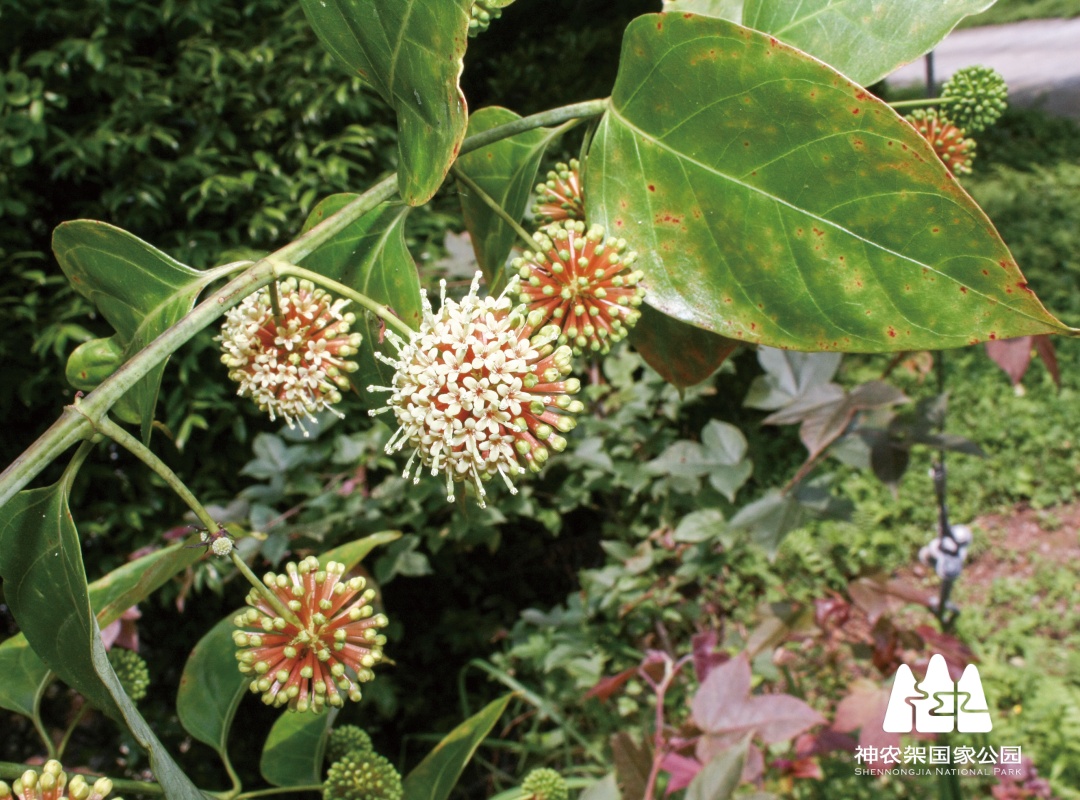Uncaria rhynchophylla: Lateral Branches Simplified for Climbing
Updated:2025-11-13 Source:Shennongjia National Park
In nature, Uncaria rhynchophylla is a relatively common woody vine belonging to the Rubiaceae family. It is mainly found in Guangdong, Guangxi, Yunnan, Guizhou, Fujian, Hunan, Hubei, Jiangxi and other provinces in China, as well as in Japan. It typically grows in sparse woods or shrubs on the banks of mountain valley streams. Its lateral branches emerge from the axils of its opposite leaves, simplify and bend downward into hooks, resembling a pair of goat horns, and allow the plant to climb on other vegetation.
Interestingly, the lateral branches of Uncaria rhynchophylla can not only bend downward to form goat horns, but can grow straight as well, forming flowering branches that produce inflorescences which resemble hydrangeas. An inflorescence is a cluster of flowers formed by dozens of small flowers growing along a single branch in accordance with a certain pattern. The flowers that make up the inflorescence bloom, wilt, and fruit in a set sequence. The inflorescences of Uncaria rhynchophylla are also reminiscent of small, hairy balls. Because the leaves of the plant grow in pairs, the lateral branches and spherical inflorescences naturally appear in pairs too. The flowers range from pale green to yellow on the inside, while the outer surface is pink, giving the plant a particularly charming appearance when in full bloom.


Upon closer examination, the small flowers are slender like pins, with the wider “pinhead” being the quinquefid top of the corolla. What we initially take to be hairs on the surface of the spheres are in fact long pistils emerging from the corolla tube. The stamens are almost half the length of the pistils, which helps to prevent self-pollination and inbreeding, thereby reducing the risk of degeneration.
For traditional Chinese medicine doctors, the hooked stems of Uncaria plants are a medicinal ingredient. Apart from Uncaria rhynchophylla itself, its sister species in the same genus, Uncaria sinensis, is also considered a high-quality medicinal ingredient. This medicine tastes sweet and bitter, its nature is slightly cold, and its effects include clearing heat, calming the liver, dispersing wind to relieve pain, and lowering blood pressure. In the Shennongjia region, farmers would pick the plant and take it home, boiling it in their children’s bathing water in order to prevent sores.
Modern pharmacological studies have revealed that the medicinal property of Uncaria plants lies in its many indole alkaloids, with the highest concentrations found in the roots and the hooked stems. Different species of Uncaria plants vary in alkaloid content, among which Uncaria rhynchophylla, Uncaria macrophylla, and Uncaria sinensis are particularly rich in rhynchophylline and isorhynchophylline.(Written by Chen Yingting Reviewed by Jiang Mingxi Photo by Jiang Mingxi)
Species File:
Uncaria rhynchophylla
Order: Gentianales
Family: Rubiaceae
Genus: Uncaria
Identification Features:
Liane; Stems are cylindrical or sub-quadrangular, with fine longitudinal striations. Nodes bear paired or single downward-curved hooks, with stipule scars beneath the hooks. Leaves are papery, elliptic or elliptic-oblong. Inflorescences are capitate, with ovate corolla lobes. Fruiting clusters are covered with short soft hairs, radiating in a stellate pattern. Flowering and fruiting period: May to December.
Distribution in China: Guangdong, Guangxi, Yunnan, Guizhou, Fujian, Hunan, Hubei, and Jiangxi.
Address:36 Chulin Road, Muyu Town, Shennongjia Forestry District, Hubei Province 鄂ICP备18005077号-3
Phone:0719-3453368



